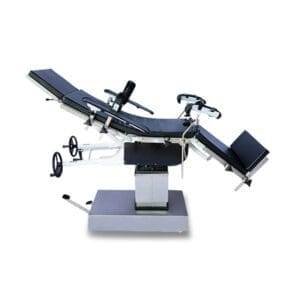Indirizzo
304 Il cardinale nord S.
Dorchester Center, MA 02124
Ore di lavoro
Dal lunedì al venerdì: 7:00 - 19:00
Fine settimana: 10:00 - 17:00
Indirizzo
304 Il cardinale nord S.
Dorchester Center, MA 02124
Ore di lavoro
Dal lunedì al venerdì: 7:00 - 19:00
Fine settimana: 10:00 - 17:00
Nel mondo delle procedure chirurgiche, precisione e sicurezza vanno di pari passo. Un elemento cruciale per garantire il benessere dei pazienti e il successo degli interventi chirurgici è il corretto utilizzo di un tavolo operatorio (tavolo operatorio). Tra i vari tipi di tavoli operatori disponibili, i tavoli operatori manuali rimangono una scelta popolare grazie alla loro affidabilità e al rapporto qualità-prezzo. Tuttavia, l'utilizzo di un tavolo operatorio manuale richiede il rispetto di rigorosi protocolli di sicurezza per ridurre al minimo i rischi e garantire un'assistenza ottimale al paziente. In questa guida completa, approfondiremo le misure di sicurezza e i protocolli essenziali da seguire durante l'utilizzo di un tavolo operatorio manuale.
 I tavoli operatori manuali costituiscono la base delle procedure chirurgiche, offrendo ai pazienti una piattaforma stabile e regolabile durante l'intervento. Questi tavoli, a differenza dei loro omologhi motorizzati, sono azionati manualmente, il che li rende affidabili e pratici per numerose strutture mediche. Per garantire la sicurezza dei pazienti e del personale chirurgico, è fondamentale avere una conoscenza approfondita dei protocolli di sicurezza associati ai tavoli operatori manuali.
I tavoli operatori manuali costituiscono la base delle procedure chirurgiche, offrendo ai pazienti una piattaforma stabile e regolabile durante l'intervento. Questi tavoli, a differenza dei loro omologhi motorizzati, sono azionati manualmente, il che li rende affidabili e pratici per numerose strutture mediche. Per garantire la sicurezza dei pazienti e del personale chirurgico, è fondamentale avere una conoscenza approfondita dei protocolli di sicurezza associati ai tavoli operatori manuali.
Prima di qualsiasi intervento chirurgico, è obbligatoria un'accurata ispezione visiva del tavolo operatorio manuale. Il personale chirurgico deve assicurarsi che il tavolo sia pulito, privo di danni visibili e che tutti i componenti siano funzionanti. Ciò include il controllo di viti allentate, imbottiture danneggiate e qualsiasi segno di usura.
Verificare che tutti i meccanismi di bloccaggio, come i blocchi delle ruote e la regolazione dell'altezza del tavolo, siano correttamente inseriti prima di posizionare il paziente. Componenti allentati o bloccati in modo non corretto possono causare instabilità durante l'intervento chirurgico.
Assicurarsi che la portata del tavolo operatorio manuale superi il carico massimo che può sopportare durante la procedura chirurgica. Il superamento del limite di peso può compromettere la sicurezza del paziente e l'integrità strutturale del tavolo.
Il posizionamento del paziente sul tavolo operatorio manuale è fondamentale sia per il successo dell'intervento chirurgico che per la sicurezza del paziente. Il personale chirurgico deve seguire protocolli precisi per il posizionamento del paziente, garantendone la sicurezza e il comfort.
Durante il posizionamento del paziente, è essenziale l'utilizzo di dispositivi di fissaggio come cinghie e barre per il braccio. Questi dispositivi impediscono movimenti involontari durante l'intervento chirurgico, riducendo il rischio di lesioni.
Una comunicazione chiara ed efficace tra i membri dell'équipe chirurgica è fondamentale. Assicurarsi che tutti siano consapevoli dei propri ruoli e responsabilità durante la procedura. Una comunicazione inadeguata può portare a errori e potenziali rischi per la sicurezza.
La collaborazione tra chirurgo e anestesista è fondamentale. Devono collaborare per coordinare il posizionamento del paziente e la somministrazione dell'anestesia, garantendo la sicurezza e il comfort del paziente durante l'intervento.
Durante l'intervento chirurgico, qualsiasi regolazione del tavolo operatorio manuale deve essere effettuata con cautela. Movimenti rapidi o bruschi possono destabilizzare il tavolo e mettere in pericolo il paziente. Le regolazioni devono essere lente e ponderate.
Il monitoraggio continuo dei parametri vitali del paziente e la somministrazione dell'anestesia sono essenziali. È necessario intervenire immediatamente in caso di cambiamenti imprevisti nelle condizioni del paziente.
 Trasferimento del paziente
Trasferimento del pazienteDopo l'intervento chirurgico, è necessario prestare attenzione durante il trasferimento del paziente dal tavolo operatorio manuale alla sala risveglio. È necessario utilizzare tecniche e dispositivi di trasferimento adeguati per evitare incidenti o lesioni.
Dopo ogni intervento chirurgico, i tavoli operatori manuali devono essere sottoposti a un accurato processo di pulizia e disinfezione, secondo i protocolli di controllo delle infezioni. Inoltre, eventuali danni o problemi osservati durante l'intervento devono essere documentati e affrontati tempestivamente.
R1: I tavoli operatori manuali sono generalmente sicuri e versatili per un'ampia gamma di procedure chirurgiche. Tuttavia, per alcune procedure, come quelle che richiedono regolazioni precise e frequenti del tavolo, potrebbero essere necessarie specifiche considerazioni di sicurezza. È fondamentale scegliere il tavolo operatorio manuale appropriato e attenersi ai protocolli di sicurezza specifici per la procedura.
R2: I tavoli operatori manuali devono essere sottoposti a manutenzione e ispezioni regolari, in conformità con le linee guida del produttore e i protocolli della struttura. La frequenza di questi controlli può variare a seconda dell'intensità di utilizzo, ma è necessario che vengano effettuati regolarmente per garantire che i tavoli rimangano in condizioni di funzionamento ottimali.
R3: Per migliorare la sicurezza, le strutture chirurgiche dovrebbero fornire una formazione completa al proprio personale sull'utilizzo manuale del tavolo operatorio e sui protocolli di sicurezza. Esercitazioni e simulazioni di sicurezza periodiche possono inoltre contribuire a preparare l'équipe chirurgica a potenziali emergenze e situazioni impreviste.
L'utilizzo di un tavolo operatorio manuale richiede il rigoroso rispetto dei protocolli e delle procedure di sicurezza. Eseguendo controlli di sicurezza pre-operatori, garantendo il corretto posizionamento e fissaggio del paziente, promuovendo un efficace coordinamento del team, implementando misure di sicurezza intraoperatorie e seguendo le procedure post-operatorie, il personale chirurgico può creare un ambiente sicuro e protetto per i pazienti sottoposti a intervento chirurgico. I tavoli operatori manuali, se utilizzati in conformità con questi protocolli di sicurezza, continuano a essere uno strumento affidabile ed essenziale nel campo della medicina chirurgica.